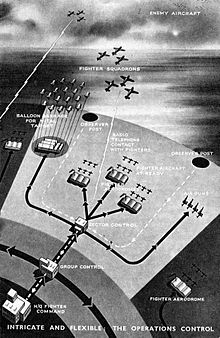道丁系统
道丁系统[a]是世界上第一个广域地面管控拦截雷达网,[2]监控从苏格兰北部到英格兰南部海岸的英国领空。它使用分布广泛的专用固网电话线路快速从本土链雷达探测站和皇家观测团收集资讯,以建立整个英国领空的单一图像,然后直接指示拦截机和高射炮对抗敌方目标。该系统由英国皇家空军在第二次世界大战开战前建造,并在不列颠战役中发挥了决定性的作用。

道丁系统是在测试证明在防空情报过时之前,向战斗机传递信息存在问题后开发的。英国皇家空军战斗机司令部指挥官,空军上将休·道丁通过使用分层传报链解决了该问题。情报被发送到宾利修道院皇家空军基地的战斗机司令部总部(FCHQ)的中央过滤室,并用于准备战斗的地图上。然后将地图的详细资讯转发给联队和扇形战区的指挥部,操作员在那里重新制作了涵盖其防空区域比例的地图。指挥官可以通过查看地图决定如何快速,而不混乱地部署他们的部队。命令仅从中队的扇区管控室传递给飞行员,通常位于战斗机的作战基地。
道丁系统被认为是英国皇家空军在不列颠战役期间成功对抗纳粹德国空军的关键。结合早期预警和迅速散布信息起到了力量加乘的作用,使战斗机部队能够以极高的效率使用。在战前时期,30%至50%的拦截率已经被认为是极好的; 这亦意味着超过一半的战斗机出动架次在没有遭遇敌机的情况下返航。在战役期间,平均拦截成功率约为90%,并且有几次拦截空袭的成功率为100%。[3] 由于缺乏自己的方位系统,德国空军战斗机对英国皇家空军战斗机的位置知之甚少,而且经常在从未遇见过他们的情况下返航基地。当他们这样做时,英国皇家空军战斗机几乎总是处于有利位置。
尽管不列颠战役的许多历史记载都评论了雷达的作用,但只有雷达与道丁系统相结合运用,雷达才真正有所效用。温斯顿·丘吉尔并没有忘记这一点,他指出:
若非有这个在战前设计和建造的系统,飓风和喷火的一切优势都是徒劳的。它是在不屈不挠的行动中塑造和完善的,现在所有的东西都融合在一起,形成了一个最复杂的战争工具,而世界上没有这样的工具存在过。[4]
注释
编辑参考
编辑引文
编辑- ^ Gough 1993,第4页.
- ^ Westley 2010.
- ^ Ministry 1941,The British Fighter Force on Guard.
- ^ The War Memoirs of Winston Churchill, Part IV. Time. 28 February 1949: 47.
文献
编辑- Bowen, Edward George. Radar Days. CRC Press. 1998. ISBN 978-0-7503-0586-0.
- Bungay, Stephen. Most Dangerous Enemy: An Illustrated History of the Battle of Britain. Zenith Press. 2010. ISBN 978-0-7603-3936-7.[失效链接]
- Burns, Russell. The Evolution of Modern British Electronics, 1930–1945. Transactions of the Newcomen Society. 2006, 76 (2): 221–234. S2CID 108454463. doi:10.1179/037201806X119822.
- Coakley, Thomas. Command and Control for War and Peace. DIANE Publishing. 1992 [2021-11-24]. ISBN 978-0-7881-0825-9. (原始内容存档于2022-04-07).
- Corrigan, R. Airborne minefields and Fighter Command's information system (PDF). GikII 2008. University of Edinburgh School of Law. September 2008 [11 January 2014]. (原始内容 (PDF)存档于23 August 2012).
- Gough, Jack. Watching the Skies: The History of Ground Radar in the Air Defence of the United Kingdom. Her Majesty's Stationery Office. 1993. ISBN 978-0117727236.
- The Battle of Britain; August – October 1940. Ministry of Information on behalf of the Air Ministry. 1941 [2021-11-24]. OCLC 5245114. (原始内容存档于2021-11-24) –通过Marshall Stelzriede's Wartime Journal.
- Ramsay, Winston (编). The Battle of Britain Then and Now Mk V. London: Battle of Britain Prints International. 1989. ISBN 978-0-900913-46-4.
- Watson, Jr., Raymond C., Radar Origins Worldwide, Trafford Publishing, 2009 [2021-11-24], ISBN 9781426991561, (原始内容存档于2022-05-12)
- Westley, Max. Pip-Squeak – the Missing Link. Duxford Radio Society Journal. Autumn–Winter 2010 [2021-11-24]. (原始内容存档于2014-01-11).
- Zimmerman, David. Britain's Shield: Radar and the Defeat of the Luftwaffe. Sutton. 2001. ISBN 978-0-7509-1799-5.
- Zimmerman, David. Information and the Air Defence Revolution, 1917–40. Goldman, Emily (编). Information & Revolutions in Military Affairs. Routledge. 2013 [2021-11-24]. ISBN 978-1-136-82779-2. (原始内容存档于2022-05-24). First published in: Zimmerman, David. Information and the Air Defence Revolution, 1917–40. Journal of Strategic Studies. 2004, 27 (2): 370–394. S2CID 153613073. doi:10.1080/0140239042000255968.
延伸阅读
编辑- Understanding The Dowding System. The Association of RAF Fighter Control Officers. [19 September 2021]. (原始内容存档于2022-07-16).
- The Battle of Britain; August – October 1940. Battle of Britain 70th Anniversary. Royal Air Force. [11 January 2014]. (原始内容存档于18 January 2013).
外部链接
编辑- The Filter Room - WW2 - Radar Command (页面存档备份,存于互联网档案馆), World War II film on the role of the Filter Room.